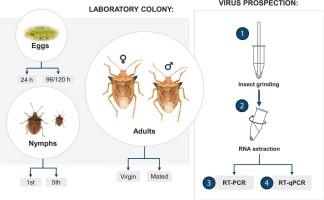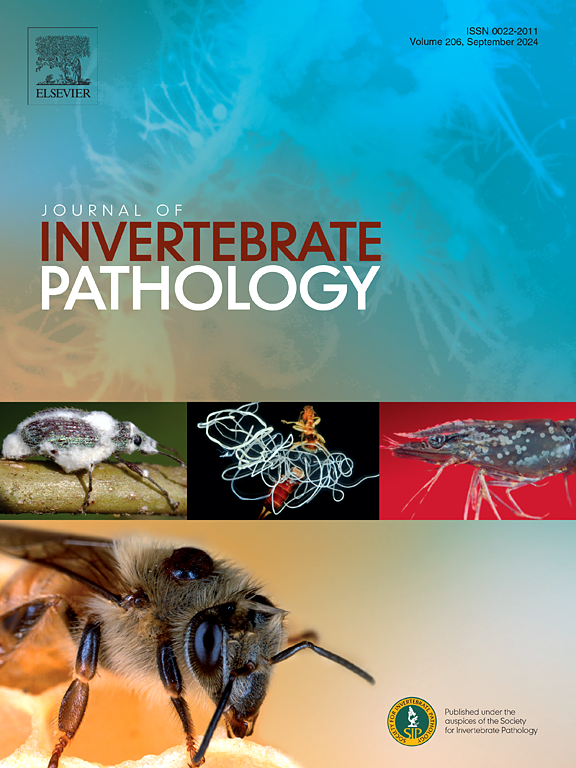新热带褐臭虫Euschistus heros病毒(EhV)在整个生命阶段的流行、复制和组织特异性定位。
IF 2.4
3区 生物学
Q1 ZOOLOGY
引用次数: 0
摘要
新热带褐臭虫(Euschistus heros,半翅目:蝽科)是巴西大豆田的主要农业害虫,在田间表现出越来越强的抗药性。本研究调查了一种多种黄疸病毒(EhV)在实验室种群中的动态。英雄们,在生命的各个阶段都有持续的全身性感染。99个成年个体的筛查显示,交配个体的EhV基因组患病率为100% %,而处女雄性和雌性的感染率为80% %。病毒载量在新产的卵中达到峰值(590,462 ± 27,426拷贝/ng RNA),表明可能是母体传播,然后在若虫中急剧下降,到第5龄时减少了18.08倍。成虫表现出性别和交配状态相关的变异,其中处女的RNA拷贝数最高(227,380 ± 144,938拷贝/ng RNA),是已交配雌虫的2.87倍。组织特异性分析显示,EhV基因组在腿/翅膀(雄性为221,723 ± 102,120拷贝/ng RNA)和头部的积累量升高,而在胸部和腹部的负荷显著降低。链特异性RT-qPCR表明,EhV可能在发育阶段表现出复制活性,这表明基因组和复制链的水平大致平衡。此外,来自受感染男性个体的触角组织的透射电子显微镜显示细胞质二十面体病毒粒子(~ 30 nm),提供了EhV组装的第一个超微结构证据。这些发现表明,超高压病毒可能与e.s heros病毒建立了稳定的、可复制的联系,并指出垂直传播是一种可能的持久性机制。然而,要确认这一模式,还需要对更大的样本量、实地采集的昆虫和补充性的实验方法进行进一步分析。本文章由计算机程序翻译,如有差异,请以英文原文为准。

Prevalence, replication, and tissue-specific localization of Euschistus heros virus (EhV) across life stages of the Neotropical brown stinkbug Euschistus heros (Hemiptera: Pentatomidae)
The Neotropical brown stink bug, Euschistus heros (Hemiptera: Pentatomidae), is a major agricultural pest in Brazilian soybean crops, exhibiting increasing insecticide resistance in field. This study investigates the dynamics of Euschistus heros virus (EhV), a multispecies iflavirus, in laboratory populations of E. heros, revealing a persistent, systemic virus infection across all life stages. Screening of 99 adults showed 100 % EhV genome prevalence in mated individuals, while virgin males and females had an 80 % infection rate. Viral loads peaked in freshly laid eggs (590,462 ± 27,426 copies/ng RNA), suggesting likely maternal transmission, before declining sharply in nymphs with an 18.08-fold reduction by the fifth instar. Adults exhibited sex- and mating-status-dependent variation, with virgin females harboring the highest copy number (227,380 ± 144,938 copies/ng RNA), which is 2.87-fold higher than mated females. Tissue-specific analysis revealed elevated EhV genome accumulation in legs/wings (221,723 ± 102,120 copies/ng RNA in males) and heads, with significantly lower loads in thoraces and abdomens. Strand-specific RT-qPCR suggested that EhV may exhibit replicative activity across developmental stages, as indicated by approximately balanced levels of genomic and replicative strands. Additionally, transmission electron microscopy of antennal tissues from an infected male individual revealed cytoplasmic icosahedral virions (∼30 nm), providing the first ultrastructural evidence of EhV assembly. These findings suggest that EhV may establish a stable, replicative association with E. heros and point to vertical transmission as a plausible mechanism of persistence. Nonetheless, confirmation of this pattern will require additional analyses with larger sample sizes, field collected insects, and complementary experimental approaches.
求助全文
通过发布文献求助,成功后即可免费获取论文全文。
去求助
来源期刊
CiteScore
6.10
自引率
5.90%
发文量
94
审稿时长
1 months
期刊介绍:
The Journal of Invertebrate Pathology presents original research articles and notes on the induction and pathogenesis of diseases of invertebrates, including the suppression of diseases in beneficial species, and the use of diseases in controlling undesirable species. In addition, the journal publishes the results of physiological, morphological, genetic, immunological and ecological studies as related to the etiologic agents of diseases of invertebrates.
The Journal of Invertebrate Pathology is the adopted journal of the Society for Invertebrate Pathology, and is available to SIP members at a special reduced price.

 求助内容:
求助内容: 应助结果提醒方式:
应助结果提醒方式:


